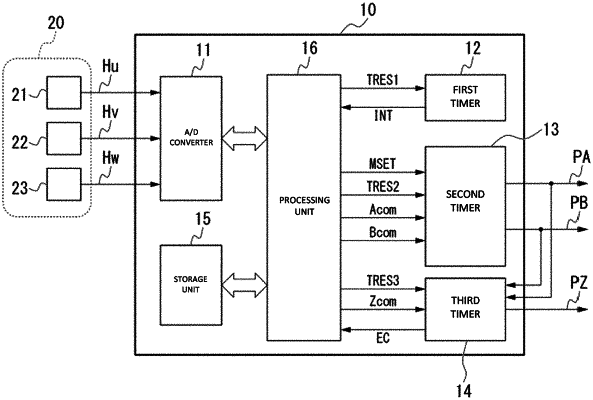| CPC G06F 13/24 (2013.01) [G06F 1/10 (2013.01); G06F 1/14 (2013.01)] | 11 Claims |

|
1. A signal generation device comprising:
a first timer to output an interrupt signal at a predetermined cycle;
a second timer to output a first pulse signal and a second pulse signal that have a predetermined phase difference;
a third timer to count a number of edges of the first pulse signal and the second pulse signal; and
a processor configured or programmed to perform interrupt processing to control an output mode of the second timer every time the interrupt signal occurs; wherein
the processor configured or programmed to perform predetermined short-period processing after performing predetermined long-period processing when an interrupt frequency, which is a number of times of occurrence of the interrupt signal, is equal to an initial value at a start of the interrupt processing, and to perform the short-period processing without performing the long-period processing when the interrupt frequency is not equal to the initial value;
the processor is configured or programmed to perform, as one of the long-period processing, angle acquisition processing to acquire a current value of an absolute angle of a rotating body; and function calculation processing to calculate an absolute angle function expressing the absolute angle as a linear function of time based on a current value and a previous value of the absolute angle; and
the processor is configured or programmed to perform, as the short-period processing:
angle estimation value calculation processing to calculate an estimation value of the absolute angle as an angle estimation value based on the absolute angle function calculated by the function calculation processing;
count value acquisition processing to acquire a count value of the number of edges from the third timer;
angle current value calculation processing to calculate a current value of the absolute angle as an angle current value based on the count value;
signal state value calculation processing to calculate a signal state value representing a relationship between a level of the first pulse signal and a level of the second pulse signal based on the count value;
timing determination processing to determine whether or not it is a timing to change the output mode of the second timer based on the angle estimation value and the angle current value;
first output mode switching processing to change the output mode of one pulse signal of the first pulse signal and the second pulse signal to one of a high-level output mode and a low-level output mode based on the signal state value, when it is determined that a timing to change the output mode in the timing determination processing;
interrupt frequency update processing to update the interrupt frequency; and
interrupt frequency reset processing to reset the interrupt frequency to the initial value when the interrupt frequency that has been updated is equal to a predetermined first threshold.
|